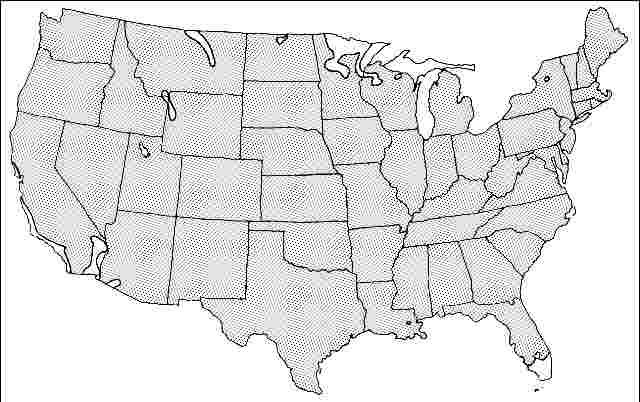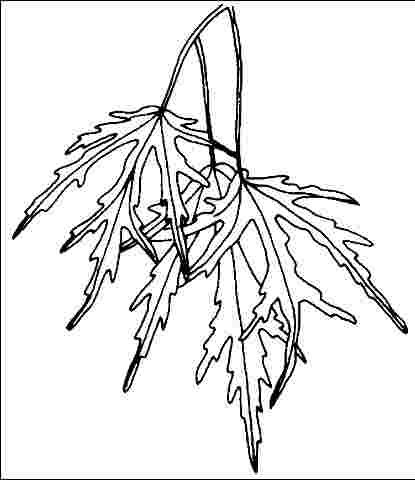Introduction
'Skinneri' silver maple is a fast-growing, weak-wooded tree that probably reaches a height of about 60 feet with a large trunk. It has a somewhat weeping, pyramidal growth form and the leaves are finely dissected, not resembling silver maple at all. Leaves almost appear as if they were injured with a herbicide, because they are so finely dissected. The tree is useful in wet areas, transplants easily and can grow where few others can grow. It should be saved for planting in wet areas or where nothing else will thrive. Roots often grow on the surface of the soil, making mowing grass difficult under the canopy. It is also hard to plant shrubs and other plants beneath the canopy due to the dense root system.

General Information
Scientific name: Acer saccharinum
Pronunciation: AY-ser sack-uh-RYE-num
Common name(s): 'Skinneri' silver maple
Family: Aceraceae
USDA hardiness zones: 3B through 9B (Fig. 2)
Origin: native to North America
Invasive potential: weedy native
Uses: urban tolerant; shade; reclamation
Availability: somewhat available, may have to go out of the region to find the tree

Description
Height: 50 to 60 feet
Spread: 40 to 60 feet
Crown uniformity: irregular
Crown shape: pyramidal, weeping
Crown density: moderate
Growth rate: fast
Texture: fine
Foliage
Leaf arrangement: opposite/subopposite (Fig. 3)
Leaf type: simple
Leaf margin: parted
Leaf shape: star-shaped
Leaf venation: palmate
Leaf type and persistence: deciduous
Leaf blade length: 2 to 4 inches, 4 to 8 inches
Leaf color: green
Fall color: yellow
Fall characteristic: showy

Flower
Flower color: red
Flower characteristics: showy
Fruit
Fruit shape: elongated
Fruit length: 1 to 3 inches
Fruit covering: dry or hard
Fruit color: green, brown
Fruit characteristics: does not attract wildlife; showy; fruit/leaves a litter problem
Trunk and Branches
Trunk/bark/branches: branches droop; not showy; typically one trunk; thorns
Pruning requirement: needed for strong structure
Breakage: susceptible to breakage
Current year twig color: reddish, brown
Current year twig thickness: thin, medium
Wood specific gravity: 0.47
Culture
Light requirement: full sun, partial sun or partial shade
Soil tolerances: sand; loam; clay; acidic; well-drained; extended flooding
Drought tolerance: high
Aerosol salt tolerance: moderate
Other
Roots: can form large surface roots
Winter interest: no
Outstanding tree: no
Ozone sensitivity: unknown
Verticillium wilt susceptibility: susceptible
Pest resistance: resistant to pests/diseases
Use and Management
Silver maple will grow in areas that have standing water for several weeks at a time. It grows best on acid soil, which remains moist, but adapts to very dry, alkaline soil. Leaves may scorch in areas with restricted soil space during dry spells in the summer but will tolerate drought if roots can grow unrestricted into a large soil volume.
Like many other large trees, it will lift sidewalks if improperly located too close to sidewalks. Locate well away from septic tanks and drain fields, since roots extend about three times the distance from the trunk to the edge of the branches. There are too many other superior trees to warrant wide use of this tree, particularly in urban areas. Silver maple is best saved for wet sites or for naturalizing in an area away from urban structures. If you must plant a silver maple, this is one of the nicest.
Silver maple is notorious for developing weak branch crotches, and the wood is brittle. Be sure to prune major limbs so they remain less than half the diameter of the trunk. This will make the structure stronger and help the tree to live longer.
Pests
Gall mites can stimulate the formation of growths or galls on the leaves. The galls are small but can be so numerous that individual leaves curl up. The most common gall is bladder gall mite found on silver maple. The galls are round and at first green but later turn red, then black, then dry up. Galls of other shapes are seen less frequently on other types of maples. Galls are not serious, so chemical controls are not needed.
Crimson erineum mite is usually found on silver maple and causes the formation of red fuzzy patches on the lower leaf surfaces. The problem is not serious so control measures are not suggested.
Aphids infest maples, usually Norway maple, and may be numerous at times. High populations can cause leaf drop. Another sign of heavy aphid infestation is honey dew on lower leaves and objects beneath the tree. Aphids are controlled by spraying or they may be left alone. If not sprayed, predatory insects will bring the aphid population under control.
Scales are an occasional problem on maples. Perhaps the most common is cottony maple scale. The insect forms a cottony mass on the lower sides of branches. Scales are usually controlled with horticultural oil sprays. Scales may also be controlled with well-timed sprays to kill the crawlers.
If borers become a problem it is an indication the tree is not growing well. Controlling borers involves keeping trees healthy. Chemical controls of existing infestations are more difficult. Proper control involves identification of the borer infesting the tree then applying insecticides at the proper time.
There are many others insect problems which can affect Silver Maple.
Diseases
Anthracnose is more of a problem in rainy seasons. The disease resembles, and may be confused with, a physiological problem called "scorch". The disease causes light brown or tan areas on the leaves. Anthracnose may be controlled by fungicides sprayed on as leaves open in the spring. Two additional sprays at two-week intervals will be needed. The disease is most common on sugar and silver maples and boxelder. Other maples may not be affected as severely. Sprays may need to be applied by a commercial applicator having proper spray equipment.
Verticillium wilt symptoms are wilting and death of branches. Infected sapwood will be stained a dark or olive green, but staining can't always be found. If staining can not be found, do not assume the problem is not verticillium wilt. Severely infected trees probably can't be saved. Lightly infected trees showing only a few wilted branches may be pulled through. Fertilize and prune lightly infected trees. This treatment will not cure the problem but may allow the tree to outgrow the infection. Girdling roots will cause symptoms that mimic verticillium wilt.
Scorch occurs during periods of high temperatures accompanied by wind, particularly in areas with limited soil space where roots cannot expand into a large soil volume. Trees with diseased or inadequate root systems will also show scorching. When trees do not get enough water they scorch. Scorch symptoms are light brown or tan dead areas between leaf veins and at the tips of the leaf. The symptoms are on all parts of the tree or only on the side exposed to sun and wind. Scorching due to dry soil may be prevented by watering. If scorching is due to an inadequate or diseased root system, watering may have no effect.
Nutrient deficiency symptoms are yellow or yellowish-green leaves with darker green veins. The most commonly deficient nutrient on maple is manganese. Implanting capsules containing a manganese source in the trunk will alleviate the symptoms. Test soil samples to determine if the soil pH is too high for best manganese availability. Plants exposed to weed killers may also show similar symptoms.